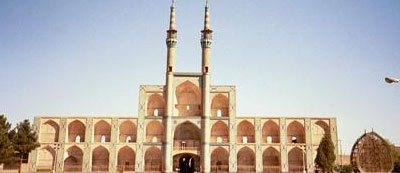
On the chest of the central plateau of Iran since more than 3000 years before Christ has stood a defiant warrior called Yasatis. Yasatis or Yazd is an ancient Iranian city that has survived many terrible events amongst them the Mongolian aggression.
Although Genghis Khan did tremendous damage to the city and its people, he was not the toughest enemy the city had to face. It was the harsh desert climate surrounding the city that constantly attacking from every direction for thousands of years. People of Yazd are renowned among Iranians as modest and humble people.
Yazd is jeweled with many magnificent architectural landmarks but one of her most attractive familiar sights which embraces many geniuses is Masjed-e Jame-e Yazd. Friday Mosque of Yazd, as it is known in English, was built around 1324 AD by an unknown architect and has been renovated and expanded many times after.
Iranians, dissimilar to their counterparts, Greeks, have always worshipped one God. Proof of this lays on the fact that Yazd is home to Zoroastrianism, a prehistoric Iranian religion that has been recognized and mentioned in the holy Quran because of worshiping a unity supreme being. As a result religion along a distinguished style of architecture has been perfectly preserved in the harmonious atmosphere that people of Yazd have nurtured.
Great artists have always dedicated or attached their masterpieces to something or somebody with incalculable value. That way they could ensure their legacy would live on even after they pass on. Some dedicated wrongfully their work of genius to an unworthy king, or in exchange of money or the fame of a celebrity and sometimes an artist has devoted his/her work of art to the God(s) or Goddess(s), the greatest insurer(s).
However all artists regardless of their nationalities or the eras they lived in have been facing this dilemma that the one that has the money to help their project to get off the ground is not usually God, who unlike the celebrities demands the least from the artists. However this is not the case for building the mosques, churches and other houses of worship. Usually ordinary people through a slow and sometimes frustrating process endow the architect with money and resources he/she needs.
It might seem that nothing is worth the trouble of getting through sluggish donation process but the freedom that architects receive from people is worth all the painful patience. Therefore before the age of skyscrapers that are now owned by the banks and insurance companies the tallest buildings in every rural town or metro cities belonged to God.
That is why Yazd’s Friday mosque possesses two tall minarets, the tallest in Iran, at the main entrance that well characterizes this masterwork from other Iranian landmarks. Due to their giant heights, the architect had to introduce a form of architectural element as “Paa Peeli”, that literary translates to ‘the elephant’s legs’ to the sides of the minarets in order to provide additional support to these massive structures made of mud and bricks.
The building’s layout, its architectural elements and its beautiful ornaments are far less glamorous compared to similar buildings such as Sheikh Lotfollah’s mosque, another architectural masterpiece in Isfahan. This is additional reason that the architecture of Yazd well reflects the image of people of Yazd as modest and humble.
Nevertheless, the simplicity and lack of show is never a repellent factor for the visitors who try to escape the heat of desert and take shelter within a heavenly place that protects its guests from noise, wind, heat, sunshine and most importantly stress by its tall, embracing and warm-colored walls and simple architectural forms. To get the feeling of getting surrounded by this magnificence






